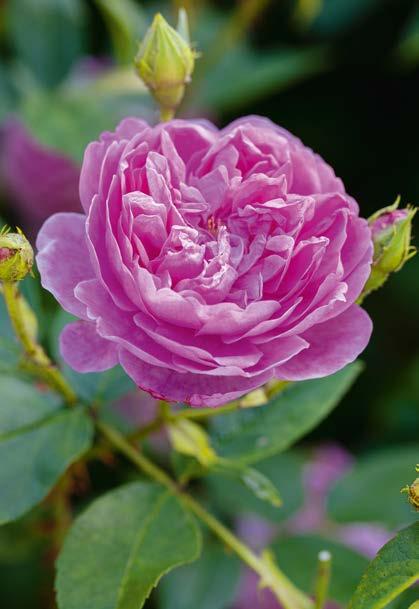
13 minute read
David Austin Jnr’s Garden The son
Like Father, LIKE SON
There was never any question that David Austin Jnr’s Shropshire garden wouldn’t include roses, but the son of the famed rosarian has used them in ways that go far beyond the traditional
WORDS NATASHA GOODFELLOW PHOTOGRAPHS RICHARD BLOOM
David Austin Jnr has filled his garden with roses including ‘Princess Anne’ as a standard, and a ‘Lady of Shalott’ hedge.

Above ‘Princess Anne’ standards emerge from beds of perennials, while a carpet of different thymes provides an unusual underplanting. Right Rosa ‘Harlow Carr’, one of hundreds of popular English roses from David Austin’s decades of breeding. T he David Austin name is synonymous with roses. In the 1950s, beguiled by the romance of the old garden roses – gallicas, damasks, albas and centifolias – David C. H. Austin (1926-2018) began crossing these pink, red and white blooms with the modern hybrid teas that were so popular at the time. His aim was to attain the perfect ‘English rose’: a plant with the beauty, grace and scent of the old varieties and the colours and repeat-flowering habit of the newcomers.
During his career he introduced around 200 new cultivars, from Rosa ‘Constance Spry’ in 1961 (not a repeat flowerer) and, in 1983, his first full successes, pink ‘Mary Rose’ and golden-petalled ‘Graham Thomas’, to lemon-yellow shrub ‘Tottering-byGently’, one of three to make a debut in 2018.



Above Rosa ‘Lady of Shalott’, a beautiful variety with orange flowers, used by David in his semi-circular hedge. Below Standard roses underplanted with Alchemilla mollis line the path to the former rectory’s front door.
It is no surprise then to learn that his eldest son, namesake and managing director of the business since 1990 shares his passion. “I genuinely feel a rose offers more diversity than any other type of plant,” says David Austin Jnr. “Few other plants can compete with roses. Peonies do, certainly in terms of their shape and form, but they’re disappointingly short flowering. I love snowdrops too, especially since they come at a time when nothing else is in flower. And irises are fantastic but they’re relatively one-dimensional. With a rose you can go from the smallest miniature to a standard to a rambler – the range of what they provide in terms of garden design is immense.” David had, of course, used roses in his previous gardens, but none afforded the scope of this 2.5 acre plot surrounding a Grade II-listed former rectory in Shropshire to which David and his partner Penny moved 11 years ago. “The garden had suffered 25 years of neglect when we took it on,” says David, “but among the tangle of rhododendrons and self-seeded sycamores, there were some fantastic specimens such as a rare handkerchief tree [Davidia involucrata] and a huge beech, indicating that somebody before me had been a great gardener. It was just the project I wanted: I could “A rose offers more see the potential.” The first step was to clear diversity than any the site to see what they had other type of plant to work with – a mammoth task that took the best part Few other plants can compete with roses” of a year, and which is still keeping the couple in firewood a decade on. What was revealed was a picture-perfect setting, looking out over fields towards Brown Clee Hill with the adjacent village church and its 12th-century tower abutting the garden’s southern edge. “It’s almost as if we’d placed it there as a garden feature,” says David, laughing. As David chopped and cleared, he planned the garden’s layout. “I took a big sheet of graph paper and drew out what I wanted,” he says, describing his vision for “a lot of flowers and different areas of interest in the front garden” and for a calmer, more relaxed space to the rear, where three streams babble through the grounds. Needless to say, roses very much form the backbone of the design. Instead of using the more typical yew or box to divide the space, David has used roses – the beautiful apricot ‘Lady of Shalott’ forming a perfect semi-circular hedge in front of the house and, elsewhere, the wilder-looking ‘Kew Gardens’ making an effective boundary between

David’s ducks and chickens keep the slugs under control so a bed packed with hostas escapes their attention.




Above left Rosa ‘Kew Gardens’ forms a low, informal hedge, covered in white flowers. Above right Rosa ‘The Country Parson’. Left ‘Morning Mist’ is a large shrub rose. Below Clusters of small pink and white flowers on Rosa ‘Ballerina’.
a small orchard and wildflower meadow. Rose standards including ‘Princess Anne’ and ‘Young Lycidas’ (“a really old-fashioned looking flower with an amazing fragrance,” notes David) add height and drama to the borders and make a refreshing change from the usual topiary. There are roses used as underplanting (a froth of ‘Ballerina’ at the base of a birch tree), roses in mixed beds and, yes, a formal rose garden, of which more later. There There are roses used as are roses trained on walls and roses trained over underplanting, roses in arches (‘The Albrighton mixed beds and, yes, a Rambler’ and ‘Malvern Hills’ – “an incredible formal rose garden rose for a large archway,” according to David) though not, interestingly, on obelisks – the only obelisk is home to a clematis. “That does seem a little remiss,” says David with a smile. Even in the verdant, relatively unadorned back garden there are roses – old rose ‘Rambling Rector’, introduced in 1899, and species roses including R. ecae, with its yellow flowers reminiscent of buttercups, and Rosa sericea subsp. omeiensis f. pteracantha, which flowers in early-mid May. That David includes older roses might seem surprising, especially when you consider that his company now trials around 6,000 new varieties every year, but he is keen to have – and to offer his customers – the very best, even if that means stocking a cultivar not bred in house. “We don’t and can’t cover every base,” he says. “There are roses that are better than anything we can do, or which offer something we haven’t yet bred.” Rosa glauca – beloved by garden designers for its grey foliage and red stems – is a case in point, as is the moss rose, ‘William Lobb’, whose moss has a scent as alluring as the rose itself. The drawback for David, however, as for his father, is that these old roses flower only once. “It’s a shame when you consider that a rose





can flower twice or more, giving you so much more pleasure from your plant.”
This attitude – of wanting as much pleasure from the garden as possible – informs not just David’s choice of roses, but his planting style as well, and it’s interesting to note that he is currently redesigning the rose garden (which had been planted with only roses, as is traditional) to include a wider palette of plants. “Commercially, I know I should be encouraging everyone to plant a rose garden,” he says, “but for sheer pleasure and to extend the flowering season even more, I think roses mixed with herbaceous perennials are just wonderful.”
In some places he combines the two quite deliberately. Along the main pathway, roses have been planted individually in bays with specific underplanting for each one to form a series of ‘portraits’ as you walk along – white ‘Desdemona’ with the sultry Astrantia ‘Hadspen Blood’ is a particular favourite. Elsewhere, the colours of a standard of ‘Princess Anne’ are echoed in the cushions of Erigeron karvinskianus and Persicaria affinis ‘Superba’ skirting its base.
It’s not all about combinations though. The garden is designed to have as long a season of interest as possible, beginning with snowdrops,
Top left Rosa ‘Malvern Hills’ softens an arch. Top right Astrantia ‘Hadspen Blood’ is an excellent rose partner. Above right The view of the front garden from above reveals its geometric layout. Above left Standard rose ‘Princess Anne’.


Top left A tranquil pond with waterlilies in a quiet corner of the garden. Top right Along the garden’s boundary, hummocks of yew are interspersed with roses Left ‘Olivia Rose Austin’, here growing as a shrub and as a standard, was named after David Austin Jnr’s daughter. crocuses, hellebores and daffodils. A large bed of hostas, “something I’ve always wanted to do,” says David, provides striking foliage for much of the year, with a flock of ducks and chickens keeping slugs in check. Two large symmetrical carpets of thyme are evergreen, aromatic and in flower from June until October, while grasses such as Calamagrostis x acutiflora ‘Karl Foerster’ and heleniums mixed with roses ‘Roald Dahl’ and ‘Tottering-by-Gently’ add colour and movement well into autumn.
No garden can be in bloom all year round, but this one, with its two glorious crescendos of roses in late May and early June, and in September-October, and a strong supporting cast for the rest of the year, manages it better than most. As David says: “Roses are all about their context and how you use them. They can hold their own as prima donnas, but when they’re complemented by other plants it makes them just that bit more special.” n

Paul’s walking no longer an uphill battle thanks to TURMERIC+
Walking is one of the most benefi cial forms of exercise, and also one of the most underestimated in terms of well-being. It’s a great way to reach the recommended level of physical activity needed to stay healthy without the toll to joints, ligaments and muscles that more demanding sports exact.

When taking longer walks however, some of us can experience skeletal and muscular discomfort. Paul Goddard, 62, a Nordic Walking instructor from Saffron Walden in Essex, swears by a product called Turmeric+ as an effective means of keeping him active. “I decided to become a Nordic Walking instructor in 2009 and started walking forty to fi fty miles a week. Two years ago it became uncomfortable to walk distances that should have been easy for someone of my age and fi tness levels. I felt very apprehensive as walking is not only my passion, but my business.” Paul continues: “I started doing some research. I learned that turmeric could be helpful and bought supplements … and then stumbled upon Turmeric+.”
Curcumin, the active ingredient in turmeric, is diffi cult for the body to absorb. Some turmeric products offer high levels of curcumin but unless this is easily absorbed by the body, the higher amounts make little difference.
The need for easy absorption is what led the scientists at FutureYou Cambridge to create Turmeric+ using the patented ‘Curcuma Phospholipid Complex’ formulation. It’s thirty times more absorbable than standard turmeric and contains vitamin C, which contributes to normal collagen formation for the normal function of cartilage.
“Soon after taking it I experienced that ‘light-bulb’ moment - I realised my knees felt like they used to. I take Turmeric+ religiously now. I walk around two hundred miles a month and even my customers have remarked on my mobility. “Walking is great for fi tness as well as your mental health. Being able to walk easily has made a huge difference to my life and I feel fi tter now than I did twenty years ago.”
Adam Cleevely, CEO of FutureYou Cambridge comments:
“We want to support more people to get active and we think Turmeric+ can play an important role in that journey. We have tens of thousands of happy Turmeric+ subscribers who regularly tell us about their positive stories, just like Paul.”
Try Turmeric+ before you buy it
CLAIM YOUR FREE SUBSCRIPTION TRIAL TODAY
Just pay £1.50 postage*
FutureYou Cambridge, the nutraceutical company known for its science-backed health supplements, is offering new customers the chance to try its fl agship product, Turmeric+, for just the cost of the £1.50 postage.* Turmeric+ was developed in Cambridge with the backing of a scientifi c advisory board including luminaries such as Dr Nicholas Shenker, a leading rheumatologist and chronic pain expert at Cambridge University Hospitals NHS Foundation Trust (Addenbrooke’s). The formulation is thirty times more absorbable than standard turmeric, and also contains vitamin C which contributes to normal collagen formation for the normal function of cartilage. Since launching the product the company has continually received positive feedback from happy customers, particularly on Trustpilot, the independent online review platform. ‘As far as I’m concerned this stuff is magic... Highly recommend!’ wrote one 5 star reviewer. ‘The product appears to meet all its promises and the service levels from FutureYou are fi rst class,’ said another. ‘We’re very happy to give people their fi rst pack for free so they can experience it for themselves,’ says Adam Cleevely, the company’s CEO. ‘It might sound bonkers but it really isn’t. We’re that confi dent in the effectiveness of our formulation. ‘I can’t think of a better way to convince people. If they like it, they will stick with it. Tens of thousands of customers already do.’
To claim your free 28 day Turmeric+ subscription trial pack worth £16.80, visit FutureYouOffers.co.uk or freephone 0800 808 5740 quoting code TF90
If it’s not for you, simply cancel your subscription at any time, without obligation.
Discount valid until 30th June 2021. Turmeric+ contains vitamin C which contributes to normal collagen formation for the normal function of cartilage and bones. New UK customers only. One free trial per household. Your fi rst box is free (Just pay £1.50 postage) and you will be enrolled into a fl exible subscription (£16.80 every 28 days). We regret but we cannot take payment for this offer and you will be enrolled into a fl exible subscription (£16.80 every 28 days). We regret but we cannot take payment for this offer by cheque. You can stop deliveries at any time without obligation. See website for more information on our subscription service. by cheque. You can stop deliveries at any time without obligation. See website for more information on our subscription service. Turmeric+ from FutureYou Cambridge should be consumed as part of a healthy and balanced diet and lifestyle. If you are taking Turmeric+ from FutureYou Cambridge should be consumed as part of a healthy and balanced diet and lifestyle. If you are taking any prescribed medication or have any medical conditions always consult your doctor or pharmacist before taking vitamins or any prescribed medication or have any medical conditions always consult your doctor or pharmacist before taking vitamins or supplements. Trial pack promotion cannot be used in conjunction with any other promotions. supplements. Trial pack promotion cannot be used in conjunction with any other promotions.
This page A mature lime towers over the entrance to Joanna Wood’s home. Opposite Viola cornuta and alliums in borders by the York stone terrace.











